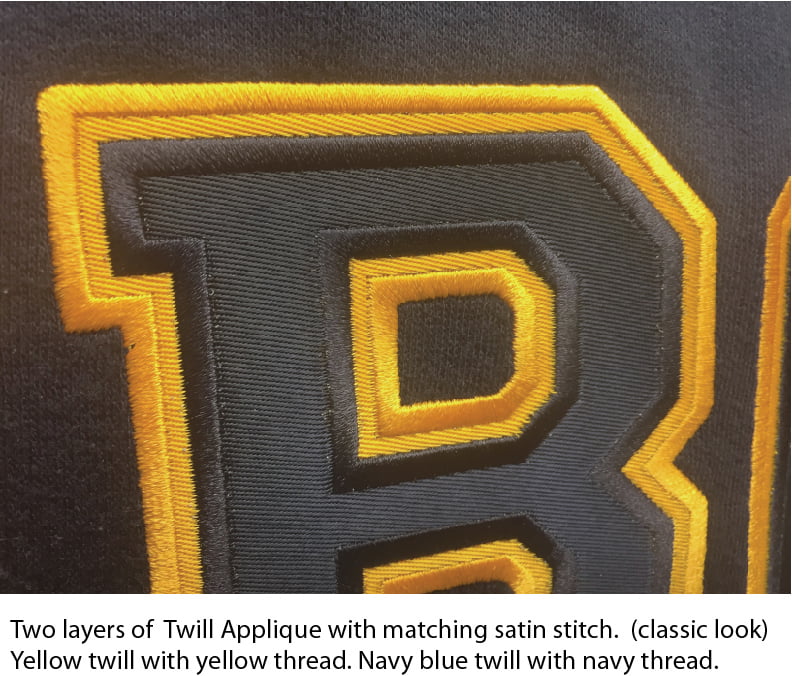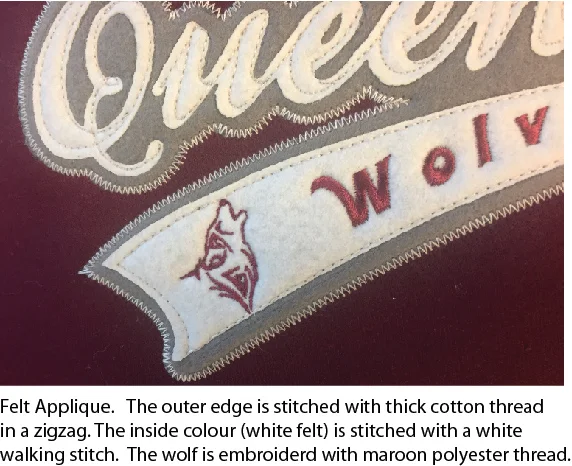Applique is the sewing on of cut-out shapes of material. Typically the shapes are letters, and the material is twill, but not always. Another common fabric is felt, and sometimes even flannel is a nice choice.
The most common applique that you might see is college letters stitched onto a hooded sweatshirt. This is often called tackle twill instead of applique. Why the different name? The best we can figure is that when football teams were interested in making fan gear with their school letters sewn on, the word “applique” sounded like something grandma did with doilies and crochet needles. So to make it sound tougher, the term ‘Tackle Twill” emerged.
Applique is a very classic look and it can be applied to many styles of clothing, as well as some hats as long as they are flat. (think toque, not ballcap) When you are deciding what you want for your applique there are a number of factors to consider that combine to make different results.
Here is some helpful information that will help you create your newest and best applique design!
What Fabric Are You Stitching Down?
The most common fabric is twill or sometimes called tackle twill (go football!). This is a stiff, woven fabric that resists shrinking and continues to lay flat after many washings. It can be stacked to multiple layers so you can get the letter in one colour, with an outline in another colour and if you are really ambitious, add another colour somewhere else.
Felt is another option for applique, although most of the time, felt is not stacked in multiple layers. One colour is recommended for the best outcome of felt applique.
Flannel is another possibility, however shrinking and tearing over time is more likely when using flannel – but really nice patterns can be found with flannel, so it might be worth the risk.

What Stitch Do You Want To Use?
Another big decision is what kind of stitch do you want to use to hold down your applique. The most common are satin stitch, zigzag stitch, and walking stitch.
Satin stitch is a cover stitch that will stitch over all of the edges of the applique fabric. It will cover the edge completely with thread adding a nice trim-like edge that completes the design. In this case, the satin stitch is definitely a part of the finished look and can sometimes be a contrasting colour giving a nice outline to the applique shape. The “B” in the image above is edged with a satin stitch.
The one disadvantage to satin stitch is that it is a lot of stitches to accomplish the look and so it can make your applique quite expensive. To stitch fully around the edges of four letters on the chest of a hoodie, on two layers of twill can sometimes be 50,000 stitches or more. This translates to a long time on the machine and so it ups the cost.
A zigzag stitch is another option that holds the fabric tight but uses way fewer stitches. It can be hidden in fabrics by not overlapping the edges and using matching thread colours, or it can be stitched with a contrast stitch colour. (See the image at the top of this post.) It is typically used on athletic applique, such as hockey jerseys. The edges of the cut twill will be visible, however, will not fray due to the fact they were cut by a laser and the edges have been melted and threads are now locked in place. Zigzag is a simpler look, and is also, much cheaper to create as it is a lot fewer stitches. The same image stitched with a zigzag as the above example of satin stitch would be around 15,000 stitches. So you can see how it would be much more cost-effective.
Walking Stitch is the best option for felt applique. A walking stitch is just a straight line stitch, one layer thick. It tacks the fabric in place and leaves the edges untouched. This is typically done on felt applique and especially on t-shirts. On t-shirts the fewer stitches the better to avoid bunching and pinching of the image after washing. Tacking the applique down with a walking stitch allows for some movement when the garment shrinks and eliminates the need for stiff backing which is uncomfortable on lightweight garments. Fabric glue will be applied between the shirt and the applique for added strength. You can see the walking stitch on the inner white felt of the image at the top of this post. Notice how the edges are left un-stitched.
Combining Applique with Embroidery
A common look is to combine applique with embroidery. Sometimes it can be as simple as stitching applique for your school’s letters for your grad wear, and then using embroidery write “Grad 2020” underneath. Other embroidered features can also be added, like names on sleeves, or activities.
Sometimes it can be more complex, where the embroidery happens on top of the twill or felt that you have stitched down. For example, add your school’s logo in embroidery on the swoosh underneath a stylized letter. (see image at top of post) This will add to the stitch count, but it is an effective way to add information or design elements that are too complex or too small to do with applique.
Combining Applique with Screen Printing
Applying a multimedia design to your garment can be very effective. Screen printing an image and then applying applique on or around it is quite a desirable look. Keep in mind that we cannot line up the two images exactly. We can get pretty close, but exact registration is just not possible. The two processes are done at separate times on separate machines and given the stretch and give of the garment, we just can’t possibly get the positioning exact every time. This isn’t necessarily a problem. Just make sure that the design elements still work with a little give in the placement.
Advantages of Tackle Twill
Tackle twill offers several advantages for decorating apparel, particularly athletic wear. First, it provides a classic, raised look that stands out and adds a touch of dimension. This creates a professional and polished appearance, ideal for jerseys and team gear. Second, tackle twill is known for its durability. The stitched application ensures it can withstand washing, wear, and even some roughhousing, making it perfect for active lifestyles. Finally, compared to some methods like embroidery, tackle twill offers a more cost-effective way to personalize clothing with names, numbers, or logos.
Applique is a Classic Look
Applique or tackle twill is a great classic look. If you are thinking you would like to put your school’s letters onto a hoodie, or create some classic-looking spirit wear for your grad class this is a great option. Or how about some tourist wear with classic Canadian red patterned flannel shaped like a polar bear or a maple leaf on sweatshirts? At GetBold, we can help you make your project a success. Give us a call to discuss your ideas, or if you are nearby, come visit the showroom to see some samples and get some ideas. Once we see your idea and know what kind of stitch you are interested in, we can give you a quote and make some recommendations for the best garments for your ideas.
At GetBold we are here to help and excited to help you create your next success with applique!
Watch a video of applique in action!
FAQ About Tackle Twill & Applique
What is applique?
Applique is the sewing on of cut-out shapes of material. Typically the shapes are letters, and the material is twill, but not always. Other common fabrics are felt and flannel.
What is tackle twill?
Tackle twill is another name for applique, especially when referring to college letters stitched onto a hooded sweatshirt.
Why is applique called tackle twill?
The term “tackle twill” is thought to have emerged to make applique sound tougher. Applique was seen as something associated with feminine crafts, so a more masculine term was desired for clothing like football jerseys.
What fabrics can be used for applique?
The most common fabrics used for applique are twill, felt, and flannel.
What are some things to consider when choosing a fabric for applique?
Some things to consider when choosing a fabric for applique include whether you want to use multiple layers, shrinking, and tearing.
What stitches can be used for applique?
Some common stitches used for applique include satin stitch, zigzag stitch, and walking stitch.
What are the pros and cons of using a satin stitch for applique?
A satin stitch is a cover stitch that will completely cover the edges of the applique fabric. This can create a nice finished look, but it also adds a lot of stitches, which can make the applique more expensive.
What are the pros and cons of using a zigzag stitch for applique?
A zigzag stitch uses fewer stitches than a satin stitch and can be hidden by using matching thread colors. It is typically used on athletic applique and leaves the edges of the cut twill visible.
What is the best stitch to use for felt applique?
The best stitch to use for felt applique is a walking stitch. A walking stitch is a straight line stitch that tacks the fabric in place without covering the edges.
Can applique be combined with other techniques?
Applique can be combined with other techniques such as embroidery and screen printing.



